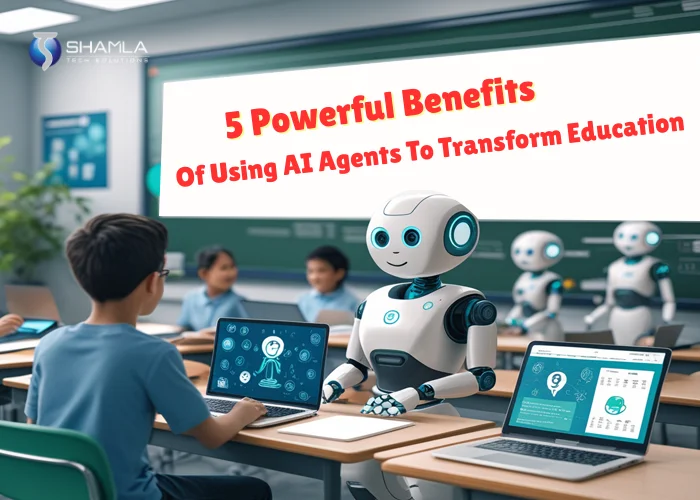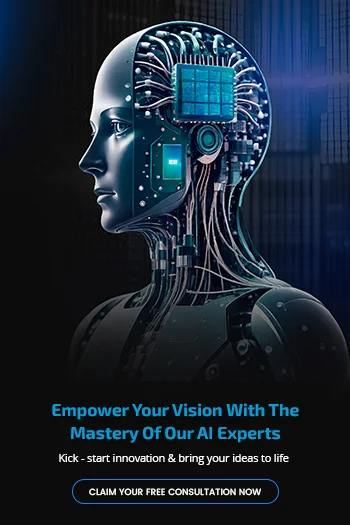Education is changing as new tech steps in. AI agents are smart programs that do tasks on their own. Schools, online classes and learning management systems now use these agents to help teachers and students.
In real-life, examples or use cases of AI agents include personalized tutoring, content curation and administrative tasks. This article shows five strong ways AI agents change education now, with clear insights and tools that teachers and learners can use today.
5 Benefits of Using AI Agents for Education
1. Personalized Learning at Scale
AI agents use data on each student’s pace, choices and skill level to set up custom lessons. They track answers, time spent and mistake patterns. Then they adjust difficulty and topic order so lessons match what each learner needs right now. This means students move forward only when they’re ready, not stuck or bored by one-size-fits-all plans. Educators see clear reports on progress so they can intervene early. This level of tailoring was once impossible in large classes but AI makes it routine and reliable.
Adaptive platforms let AI agents deliver quizzes that shift in real time based on student responses. Content recommendation engines suggest videos, articles or practice tasks that fit a learner’s interest and challenge level. For example, a student who struggles with fractions gets extra practice problems, while another who excels moves to decimals. These use cases of AI agents show how systems can automate what a tutor does one-on-one. Teachers who are curious on how to build an AI agent, can find frameworks and APIs that simplify integration into existing learning software.
Adaptive platforms let AI agents deliver quizzes that shift in real time based on student responses. Content recommendation engines suggest videos, articles or practice tasks that fit a learner’s interest and challenge level. For example, a student who struggles with fractions gets extra practice problems, while another who excels moves to decimals. These use cases of AI agents show how systems can automate what a tutor does one-on-one. Teachers who are curious on how to build an AI agent, can find frameworks and APIs that simplify integration into existing learning software.
Key Advantages
- Real-time adaptation: AI shifts quizzes and lessons instantly based on student inputs.
- Custom content paths: Each learner follows a unique sequence of topics and tasks.
- Accessibility support: Agents add text-to-speech, simplified language and step-by-step guides.
- Engagement metrics: Detailed dashboards show participation, help requests and completion rates.
- Teacher insights: Reports highlight class-wide trends and individual struggles for targeted help.
2. Intelligent Tutoring and On-Demand Support
AI tutors act as tutors around the clock, answering questions at any time. These intelligent AI agent systems parse queries, break down problems and offer stepwise help without wait. Students submit questions via chat, voice or form. The system uses NLP to understand context and generates clear responses. It monitors progress and adapts its approach based on past interactions. Round-the-clock support ensures learners never stall on tricky topics. By handling routine tutoring tasks, these agents deliver consistent guidance and free students from scheduling constraints.
Many LMS platforms now integrate ChatGPT-style assistants directly into course pages and apps. These bots leverage machine learning models to process assignment prompts and student notes. They connect to knowledge bases and course resources, pulling examples and explanations. Instructors set guardrails so responses match curriculum objectives. Students engage in dialog, testing hypotheses and receiving instant feedback. This tight integration speeds idea exploration and reduces friction. By embedding assistance where learners already work, platforms boost adoption and satisfaction without extra tools or plugins.
AI Agents evaluate multiple choice, short answer and code submissions instantly, flagging errors and patterns. Instructors review summarized reports instead of every submission. This cuts workload and prevents burnout as class sizes grow. The system logs interactions, highlighting questions that need human insight. By automating routine tasks, these agents lower instructor stress and maintain high teaching standards across large student groups.
Students practice math, science and coding problems with real-time hints and code reviews. AI agents run simulations, check work and suggest next steps. They spot mistakes in algebra steps, debug code snippets and explain lab concepts clearly. This on-demand help fosters trial-and-error learning without fear of failure. As students see instant solutions, their confidence grows and they tackle harder problems. The system tracks skill gains and adjusts challenges.
Key Benefits
- 24/7 instant help reduces learner wait and frustration
- Personalized hints guide step-by-step problem solving
- Automated grading frees instructors for high-value tasks
- Confidence increases through immediate feedback and support
- Self-paced progress adjusts workloads to student needs
- Data logs reveal skill gaps for targeted teaching interventions
3. Automating Administrative and Grading Tasks
AI agents take over grading quizzes, marking attendance, setting schedules and sending messages. They connect with learning management systems to pull grades, check login records and email reminders. This cuts manual work by up to 80 percent in large classes. Auto-grading handles multiple-choice and short answers, then sends results to student dashboards. By handling routine admin, these agents free schools from paperwork and speed up every process.
By offloading these chores, teachers gain hours each week to teach and coach. Manual grading of essays and coding projects can eat ten hours per instructor. Systems escalate complex cases, plagiarism alerts or grading disputes, for human review. This shift boosts lesson planning and deep support, rather than repetitive admin work. As AI agents transform the future of work, educators gain more time for high-impact tasks.
Errors drop and tasks finish faster when AI drives data entry and calculations. Attendance errors drop below one percent versus five percent in manual logs. Grade totals and averages update instantly after submissions, cutting correction loops. Scheduling engines auto-slot classes, exams and office hours without clashes. Bulk email and notification batches run in seconds instead of hours. By replacing repetitive chores, these agents cut late reports and reduce audit issues in accredited programs.
Large-scale online courses and MOOCs rely on smooth workflows to keep thousands on track. AI systems batch-grade hundreds of submissions, issue certificates and open new course sections when demand spikes. They track drop-out rates in real time and trigger outreach messages. Integration with calendar APIs and chat tools means students enroll, pay and join classes without human touchpoints. This lowers support tickets and boosts teacher satisfaction, since they handle only the tough questions.
Key Benefits
- Logs attendance automatically via clicks or badge scans
- Auto-schedules classes and exams without time conflicts
- Sends bulk messages and reminders in seconds
- Flags errors and plagiarism for quick review
- Frees teachers for teaching, coaching and content design
4. Enhancing Engagement with Interactive Learning
AI agents power hands-on simulations, game-like tasks and virtual worlds that pull students into lessons. Learners steer 3D labs, test ideas and see results in real time. Game rules reward correct answers with points, badges or unlocks. Virtual stages let students explore history scenes or science models safely. These tools break up lectures and spark interest. By using simple controls and clear feedback, they make tough topics feel like puzzles to solve rather than chores to finish. This style boosts focus and the will to learn more.
Conversational guides walk students through ideas step by step, asking questions and giving hints as needed. Chat bots embedded in lessons answer follow-ups, explain terms and offer extra practice. These “talking tutors” follow scripts set by teachers but learn from each student’s output. AI agent examples include chat assistants that rephrase math steps or narrate science demos. These bots open dialogs instead of one-way slides. Students ask “why” and get clear replies at once, so they stay on task and build trust in their own skills.
AR and VR tools let learners step inside concepts. In virtual labs, chemistry students mix safe digital chemicals and watch reactions up close. Medical trainees practice surgery on 3D avatars before working on real patients. Language learners roam city scenes, ordering food or asking for directions in VR. These immersive setups cut distractions and help memory by linking ideas to actions. Simple headsets or phone apps run these lessons without heavy gear. The result is a clear, hands-on feel that beats reading text or watching videos alone.
Real-world runs show these methods work. In language classes, interactive games raise vocabulary scores by 20 percent. Nursing students in VR sims make 30 percent fewer errors on first attempts. History labs in virtual scenes boost quiz scores and class chat. Science quizzes inside simulations cut drop-out rates and spark topic chats. These outcomes prove that mixing AI power with play and immersion feeds curiosity and deep learning better than text tests or slide shows alone.
Key Interactive Features
- Live 3D simulations for hands-on labs
- Game tasks with points, badges and unlocks
- Virtual worlds for history, science or languageChat guides that ask, hint and explain
- AR/VR scenarios for safe practice
- Role-play setups to boost real-world skills
5. Real-Time Analytics and Predictive Insights
AI agents watch what each student does, how long they spend on lessons, how they answer questions, and what they click on, all in real time. They feed this data into dashboards that update instantly, giving teachers clear views of class performance. Instructors see heat maps of tough topics and drill down to individual struggles. This continuous flow of data replaces end-of-term reports with live insights. By turning raw activity into clear charts and alerts, educators make fast, informed choices that keep students on track and lessons sharp.
AI fits behavior patterns, missed deadlines, low quiz scores, long pauses, into risk scores. When a learner dips below a threshold, the system sends alerts to teachers or advisers. Early warnings let mentors schedule check-ins or assign extra practice before issues grow. This approach cuts failure rates by up to 30 percent. By spotting warning signs early, schools boost pass rates and keep learners motivated through timely support.
Data from these agents guides curriculum tweaks and teaching methods. If analytics show low engagement on certain modules, educators revamp content or teaching style. Schools use A/B testing, two lesson versions run side by side—to see which format works best. Over time, real-time metrics refine pacing, quiz difficulty and resource mix. This loop makes each course smarter and more efficient. Teams using agile lesson design stay ahead of learner needs and avoid one-size-fits-all pitfalls in both online and in-person settings.
Several universities report gains from AI analytics. A mid-size college cut drop-out rates by 25 percent after deploying real-time alerts in its LMS. A vocational school boosted certification pass rates by 15 percent through data-driven content tweaks. A K–12 district used predictive scores to launch peer-tutoring before tests, raising average scores by two letter grades. These case studies show how AI agent development paired with clear action plans drives long-term benefits: higher retention, better grades and more confident learners ready for future challenges.
Key Benefits
- Live dashboards update class and individual metrics instantly
- Early-warning alerts flag at-risk students for quick help
- Course content adjusts based on engagement and outcome data
- A/B tests refine lessons for best learning formats
- Real-time reports speed up teaching decisions
- Long-term gains: higher retention and improved grades
Conclusion
AI agents deliver data-driven lessons, instant feedback and predictive alerts, reshaping education. They adjust tasks to each learner, track performance in real time and guide interventions. These tools cut manual work, boost engagement and lift outcomes. AI agents turn classrooms and online platforms into adaptive, efficient learning ecosystems now.
Shamla Tech is an AI agent development company that builds AI agents that automate tasks, analyze data and enable smart actions across sectors. We design, test and deploy custom solutions in education, finance, healthcare and retail. Our clients gain faster insights, streamlined processes and higher ROI.



